 Victoria Battery Relics |
The bush-lined road between Paeroa and Waihi features the Karangahake Gorge. This is an interesting area to hike in, covering old Maori trails and a lot of industrial archaeology such as old mines and rail detritus. The Karangahake Gorge Historic Walkway partly follows the old railway line between Paeroa and Waihi (closed in 1979), with the remainder of the track following the banks of the Ohinemuri River. The mining aspects particularly attracted me to this gorge, so naturally I chose the first fine day that came along to hike along the trail.
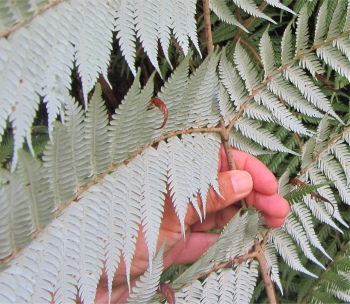 New Zealand Silver Fern |
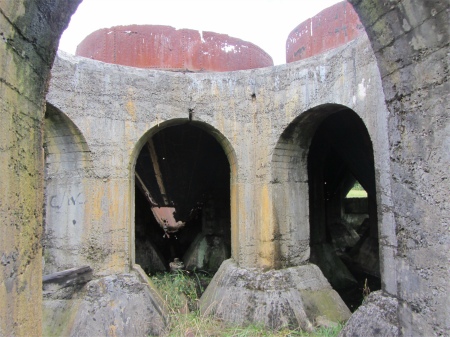 Cyanide Tank Foundations |
Years passed and he came to love her, as she did him as a beloved father. When peace finally came, the tribe returned to look for their princess. Because of her noble heritage, she had no choice but to return to her people. Broken hearted, Ureia left the area and was only seen occasionally watching over the river. Today it is said that when the mist falls from Karangahake Mountain and the dew rises from the Ohinemuri River, they are the tears of Ohinemuri and Ureia who still pine for each other.
 Flowers Along the Karangahake Gorge Historic Walkway |
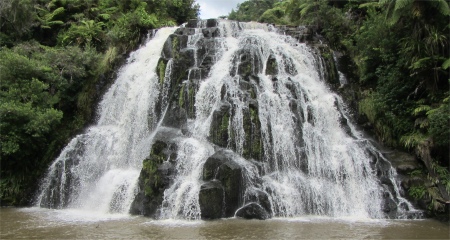 Owharoa Falls |
A major breakthrough occurred in 1889 with the introduction of the McArthur-Forrest cyanide process for extracting gold from quartz, which enabled a dramatic increase in gold recovery. Three large batteries were built at Karangahake in the 1890s, the Crown, Talisman and Woodstock, for the treatment of ore taken from extensive mine networks inside Karangahake Mountain. Output from the Karangahake quartz mines in 1909 made up 60% of the total gold produced in New Zealand.
I started my hike from the Waikino Station. Waikino was established as a service town for the Victoria Battery. The battery was built here because two rivers and a large stream were available for water power. Gold ore was brought in from Waihi on a private railway.
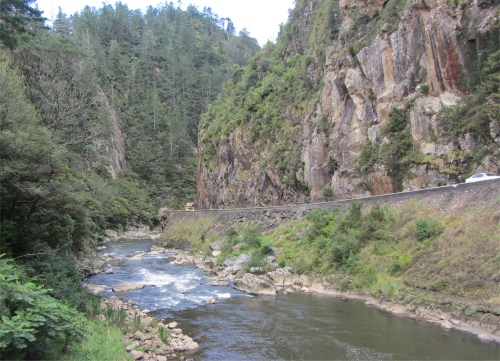 Karangahake Gorge |
The hike took me under SH2 and across the Ohinemuri River to Victoria Battery itself. The battery was built in 1898 to process gold ore from the Martha mine at Waihi. The battery had huge buildings for different stages of the gold recovery process, including a huge construction to hold a set of 15m high potassium cyanide tanks. Up to 800 men worked at the battery in three shifts. 200 steel stampers, capable of crushing up to 800 tons of ore each day, smashed the gold ore into dust, creating a deafening sound day after day.
Travellers from all around the world came here to work in the gold mining industry. Many came from Auckland. Others came from countries such as Australia and Britain. Towns nearby expanded rapidly with the growing numbers of migrants.
One such settler was Joseph Killey. He came from Liverpool in 1926 and got a job as an accountant for the Waihi Goldmining Company. He was later promoted from Auckland to Waikino. He then worked in administration here until the battery was closed in 1952. Later he served as a Waihi Borough Councillor between 1965 and 1971.
 Mine Entrances Along the Waitawheta River leading to the 173km of Tunnels |
"I found it difficult to reconcile the prosperity of the company with the primitive working conditions and sub-standard housing for staff. But in those days any job was a good job and gold mining was one of the few industries not affected by the worldwide depression".
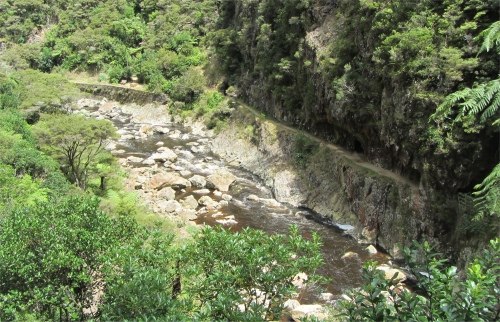 Crown Tramway Track by the Waitawheta River |
Today, a substantial set of ruins stood where the vast Victoria Battery once dominated the scene. Sadly, the museum in the transformer building was closed, but the display boards told enough of the story to illustrate how large the complex was and how it functioned.
I proceeded along the trail to the Owharoa Falls. Nearby the Owharoa mines once operated. Although Owharoa was not a major gold-producing area, it was consistently worked from 1875 until about 1941 by a number of companies.
The small township of Owharoa, with its hotels, stores, houses, a school and battery buildings, once filled this area. After 1896 it was overshadowed by the nearby town of Waikino. Nothing now remains of the settlement.
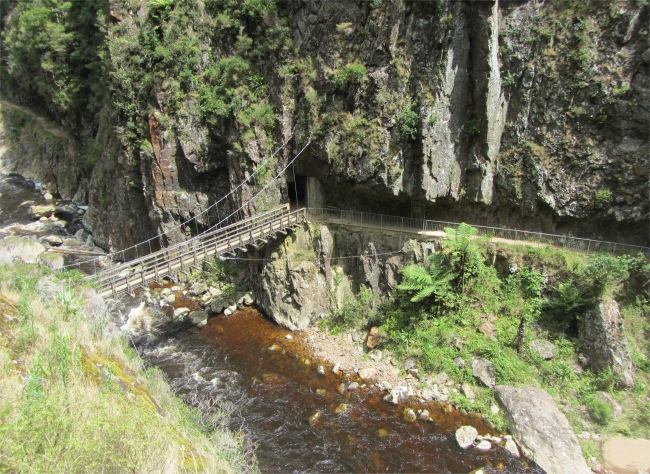 Suspension Bridge over the Waitawheta River |
On the last stage of the Historic Walkway, I chose to walk through the 1km long rail tunnel, which brought me out to a bridge which crossed SH2 and the Ohinemuri River, and led me to the Crown Battery.
The Crown Battery was constructed during 1892, and by 1898 had been enlarged to accommodate 60 stampers for crushing quartz. The machinery was powered at first by three Pelton water wheels, and later by steam and electricity. Water was conveyed to the battery by water races from the Ohinemuri and Waitawheta Rivers. A horse tramway was built in the Waitawheta Gorge to transport the quartz from the mine to the mill. The Crown Company's most prosperous years were between 1898 and 1903. Decreasing returns of rich quartz and flooding in the lower levels of the mine led to a decline in operations after 1905. By 1916 major work in the mine and battery had ceased.
I took a hike upstream to the Karangahake Reserve, and from there a short walk along the Waitawheta River on the Crown Tramway Track was rewarded with spectacular scenery. The walk snaked along a path clinging to cliff sides, with a few old mine tunnels along the way, disappearing deep into the cliffs. The track brought me to the Woodstock Underground Pumphouse, a huge underground cavern constructed to house the enormous pumping machinery needed to de-water the mine levels below the river.
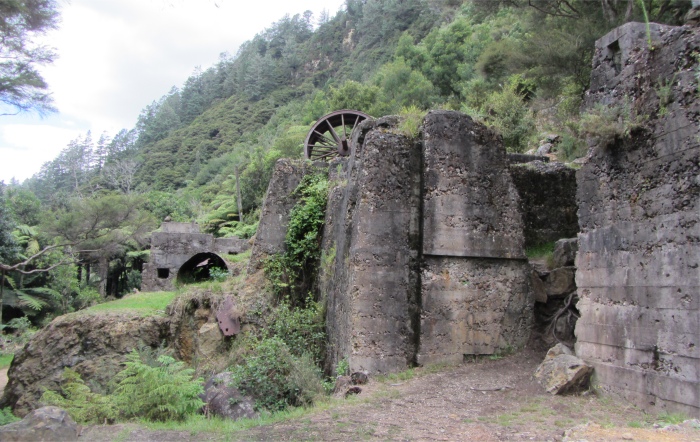 Woodstock Battery |
I tried to return back to the Karangahake Reserve by following the Windows Walk, a tunnel which has window-like openings which look down on the Waitawheta River gorge far below. However, I had forgotten to bring a torch, so I reluctantly turned back and returned the same route back to the reserve via the Crown Tramway Track.
The long hike back to my wagon now lay ahead of me. To add a small amount of variety, I decided not to walk back through the 1km rail tunnel, but follow a track that skirted the Ohinemuri River. This conveniently took me past the Woodstock Battery.
The point where the Ohinemuri and Waitawheta Rivers join was once the focus of the Karangahake gold mining industry. The Woodstock and Talisman Batteries, which stood at the confluence of these two rivers, were expanded and reconstructed as gold returns increased. By late 1901 the Woodstock had 40 stampers, and the Talisman had 50 stampers, with buildings on both sides of the Waitawheta River.
Woodstock's plant and property was taken over by the Talisman Consolidated Gold Mining Company in 1904. Talisman recovered well over three million ounces of gold and silver bullion before it ceased operations in 1918. At its peak Karangahake was the second largest producer of gold in the Hauraki Goldfields (after the Martha Mine at Waihi).
The area is so peaceful now that it's hard to imagine the ear-shattering rhythmic thumping of the battery stamper heads pounding 24-hours-a-day. Today, remaining foundations, tunnels, kilns, and tramways offer an enduring legacy of the boom time.
My trip back up the gorge was uneventful, which gave me plenty of time to try and comprehend the misery that the miners must have had to endure, and I tried to conjure up in my imagination how this industrial area would have looked and sounded a century or so ago.
It had been an excellent exploration day, and I was glad to have come across another rare example of New Zealand industrial archaeology. The only other examples I had come across so far were to be found at Denniston.
